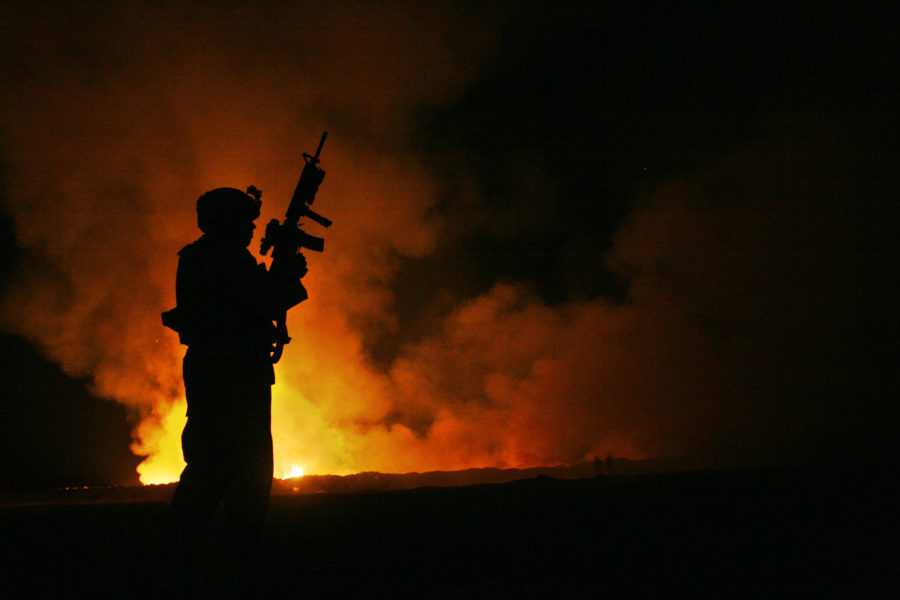The White House directed the Department of Veterans Affairs to help veterans exposed to burn pits and other in-service toxic hazards get the care they need, but a leading veterans group says the effort is just more “wonky doublespeak that doesn’t accomplish or change anything.”
During the two decades of U.S. involvement in Afghanistan and Iraq, a widespread practice of toxic burn pits exposed thousands of service members to carcinogens who have developed diseases decades after service separation, making the veterans ineligible for care if they cannot prove their disease was service related. Despite high-profile efforts by the likes of Sen. Kirsten Gillibrand (D-N.Y.) and comedian Jon Stewart, who helped pass similar legislation for 9/11 first responders, numerous bills have floundered. Now the VA is taking another approach through a pilot program and “exposure model.”
“The goal of this new model is to lower the burden of proof for veterans impacted by exposures and [to] speed up the delivery of health care and benefits they need,” a Nov. 11 VA press release stated.
“We are seeking more information from veterans, more evidence from more sources, and looking to take every avenue possible to determine where a potential presumptive illness based on military service location may exist in a more expedient and holistic manner,” said VA Secretary Denis McDonough in a statement. “We want all veterans who may have been impacted to file a claim even if it was previously denied.”
But a veterans group says creating another model to study possible relationships of in-service environmental hazards to medical conditions is not the promise of presumption of disease they need for immediate care.
“This does nothing and is insulting,” said Mark T. Jackson, an Army veteran working on behalf of the Stronghold Freedom Foundation, which represents service members who served at Karshi-Khanabad (K2) Air Base, a secret Uzbek staging base for the invasion of Afghanistan. Veterans assigned there have since developed numerous rare cancers and other ailments.
“The solution is automatic presumption of service connection for ANY veteran who presents ANY illness known to be caused by the carcinogens known to be present in burn pits, radiation, and contaminate soils,” Jackson said via e-mail. “It’s mostly wonky doublespeak that doesn’t accomplish or change anything.”
A White House fact sheet acknowledged there are “gaps and delays” in the scientific evidence showing a conclusive link to adverse health impacts, which include a range of respiratory and gastrointestinal ailments. The result is that many veterans do not have access to VA care.
The new VA “comprehensive military exposure model” goes beyond what science can prove to include other scientific research and factors, but it does not require any changes.
“VA developed a new model to accelerate the decision-making process to consider adding new presumptive conditions,” the statement read.
House Committee on Veterans’ Affairs Chairman Mark Takano (D-Calif.), who sponsored an omnibus bill to help veterans exposed to toxins, said in a statement Nov. 11 that the new model is a good start but that legislation is also needed.
“For too long, veterans have had to prove that they were exposed to toxicants by their government or face waiting decades for the science and presumption decisions to catch up,” Takano said in the statement.
The move will “attempt to reduce that burden and ultimately, speed up the delivery of” benefits, he added.
“We still must pass comprehensive legislation to ensure all veterans exposed to toxins during their service have access to VA’s high quality care and benefits,” he said. “Today’s announcement makes it clear—the momentum is on our side.”
Jackson worries the move just buys the VA more time to look at its own data and practices while sick veterans continue to fend for themselves.
“They are going to review a few diseases with their new model and develop a new one and then give themselves 90 days to then consider a change to rulemaking,” he said. “If that works, they intend to use the model on other conditions with the same non-committal outcome.”
Jackson said veterans must apply within 10 years for some conditions, while for Iraq War veterans, the grace period is just five years. The White House fact sheet calls on Congress to extend the period of coverage after separation for 3 million Iraq veterans.
“This is another betrayal wrapped up in wonktalk and lawyerese that does precisely nothing for K2 vets or any veteran suffering—or who will one day suffer—from diseases caused by burn pits,” Jackson said.
For the Pentagon’s part, spokesperson John F. Kirby said Nov. 15 that Secretary Lloyd J. Austin III would throw his weight behind the effort.
“This is an issue that the Secretary takes very seriously,” Kirby said in response to a question from Air Force Magazine. “[Austin] fully supports the VA Secretary’s desire to make care for these maladies more available and to reduce the burden on our veterans of proof.”


